MITSUBISHI COLT 2011 Owner's Manual (in English)
Manufacturer: MITSUBISHI, Model Year: 2011, Model line: COLT, Model: MITSUBISHI COLT 2011Pages: 274, PDF Size: 17.88 MB
Page 181 of 274
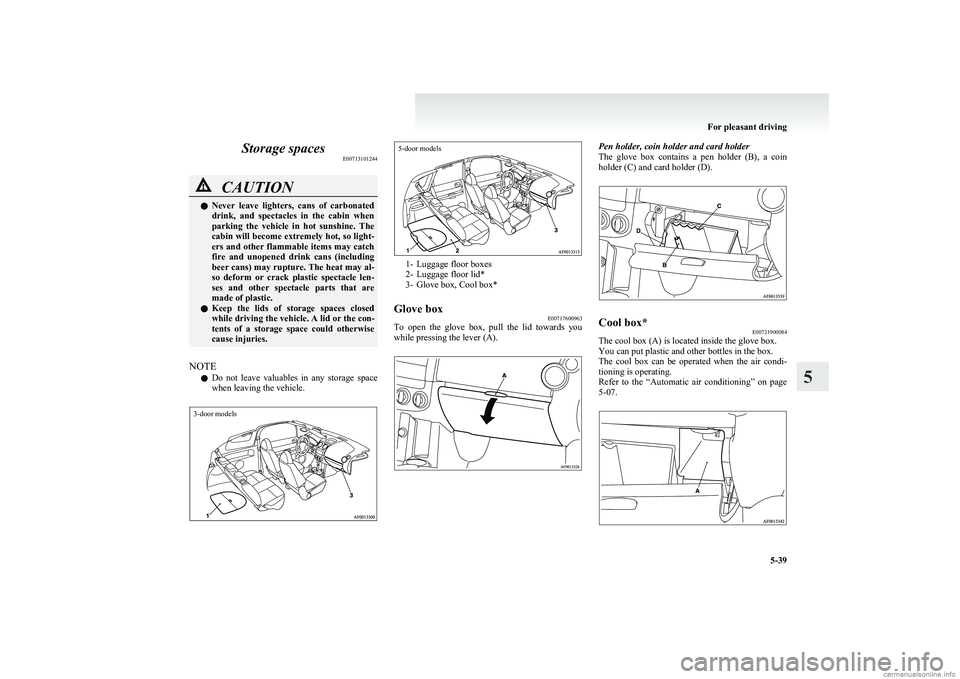
Storage spacesE00713101244CAUTIONlNever leave lighters, cans of carbonated
drink, and spectacles in the cabin when
parking the vehicle in hot sunshine. The
cabin will become extremely hot, so light-
ers and other flammable items may catch
fire and unopened drink cans (including
beer cans) may rupture. The heat may al-
so deform or crack plastic spectacle len-
ses and other spectacle parts that are
made of plastic.
l Keep the lids of storage spaces closed
while driving the vehicle. A lid or the con-
tents of a storage space could otherwise
cause injuries.
NOTE
l Do not leave valuables in any storage space
when leaving the vehicle.
3-door models5-door models
1- Luggage floor boxes
2- Luggage floor lid*
3- Glove box, Cool box*
Glove box E00717600963
To open the glove box, pull the lid towards you
while pressing the lever (A).
Pen holder, coin holder and card holder
The glove box contains a pen holder (B), a coin
holder (C) and card holder (D).Cool box* E00721900084
The cool box (A) is located inside the glove box.
You can put plastic and other bottles in the box.
The cool box can be operated when the air condi-
tioning is operating.
Refer to the “Automatic air conditioning” on page
5-07.
For pleasant driving
5-39
5
Page 182 of 274
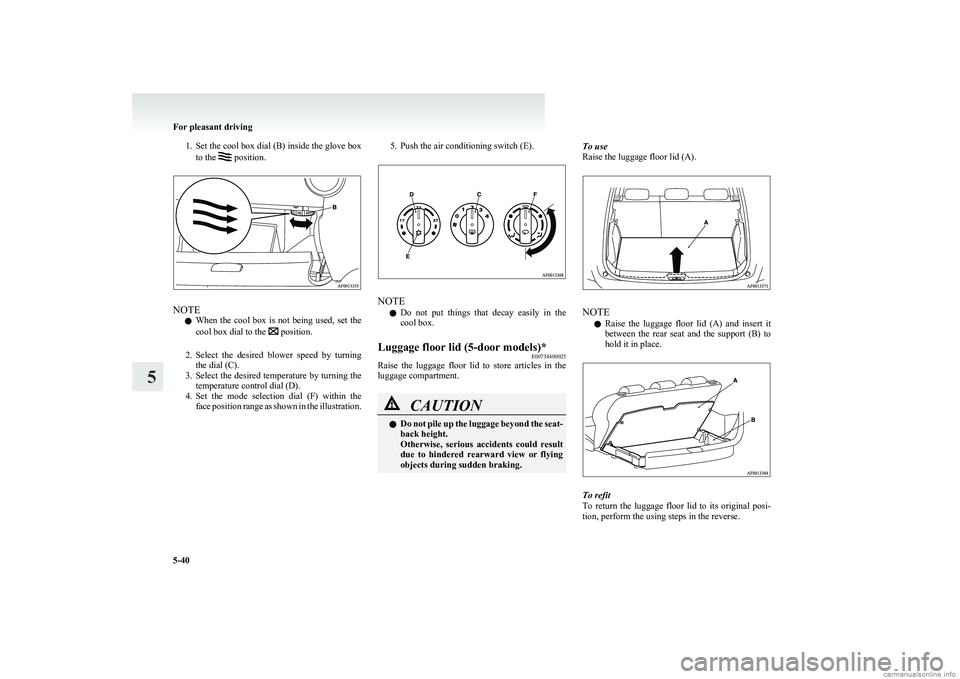
1.Set the cool box dial (B) inside the glove box
to the position.
NOTE
l When the cool box is not being used, set the
cool box dial to the
position.
2. Select the desired blower speed by turning
the dial (C).
3. Select the desired temperature by turning the
temperature control dial (D).
4. Set the mode selection dial (F) within the
face position range as shown in the illustration.
5. Push the air conditioning switch (E).
NOTE
l Do not put things that decay easily in the
cool box.
Luggage floor lid (5-door models)* E00734400025
Raise the luggage floor lid to store articles in the
luggage compartment.
CAUTIONl Do not pile up the luggage beyond the seat-
back height.
Otherwise, serious accidents could result
due to hindered rearward view or flying
objects during sudden braking.To use
Raise the luggage floor lid (A).
NOTE
l Raise the luggage floor lid (A) and insert it
between the rear seat and the support (B) to
hold it in place.
To refit
To return the luggage floor lid to its original posi-
tion, perform the using steps in the reverse.
For pleasant driving
5-40
5
Page 183 of 274
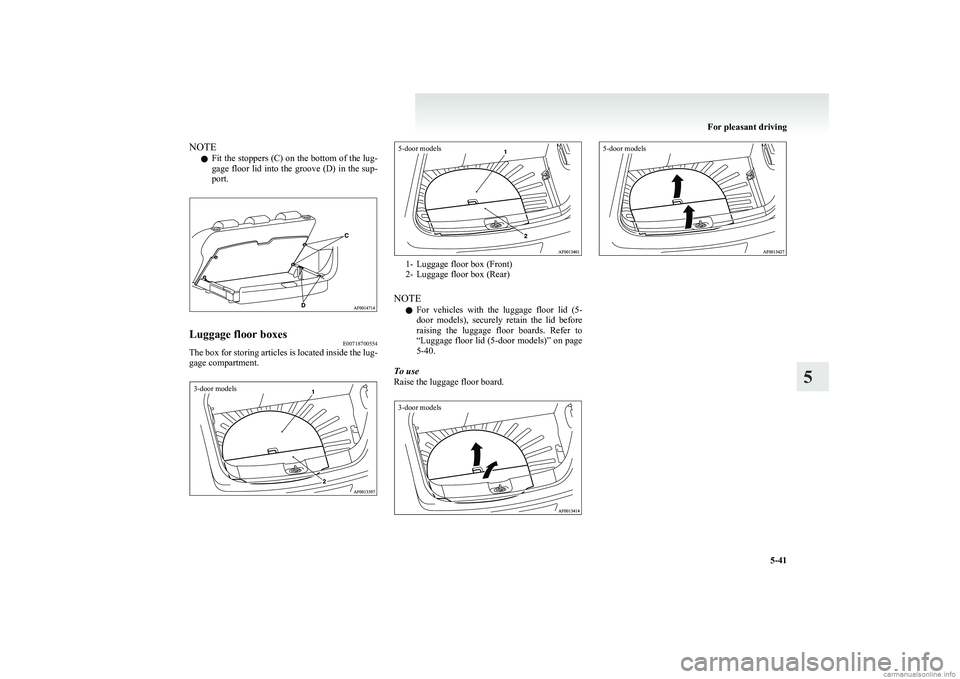
NOTEl Fit the stoppers (C) on the bottom of the lug-
gage floor lid into the groove (D) in the sup-
port.Luggage floor boxes E00718700554
The box for storing articles is located inside the lug-
gage compartment.
3-door models5-door models
1- Luggage floor box (Front)
2- Luggage floor box (Rear)
NOTE l For vehicles with the luggage floor lid (5-
door models), securely retain the lid before
raising the luggage floor boards. Refer to
“ Luggage floor lid (5-door models)” on page
5-40.
To use
Raise the luggage floor board.
3-door models5-door models
For pleasant driving
5-41
5
Page 184 of 274
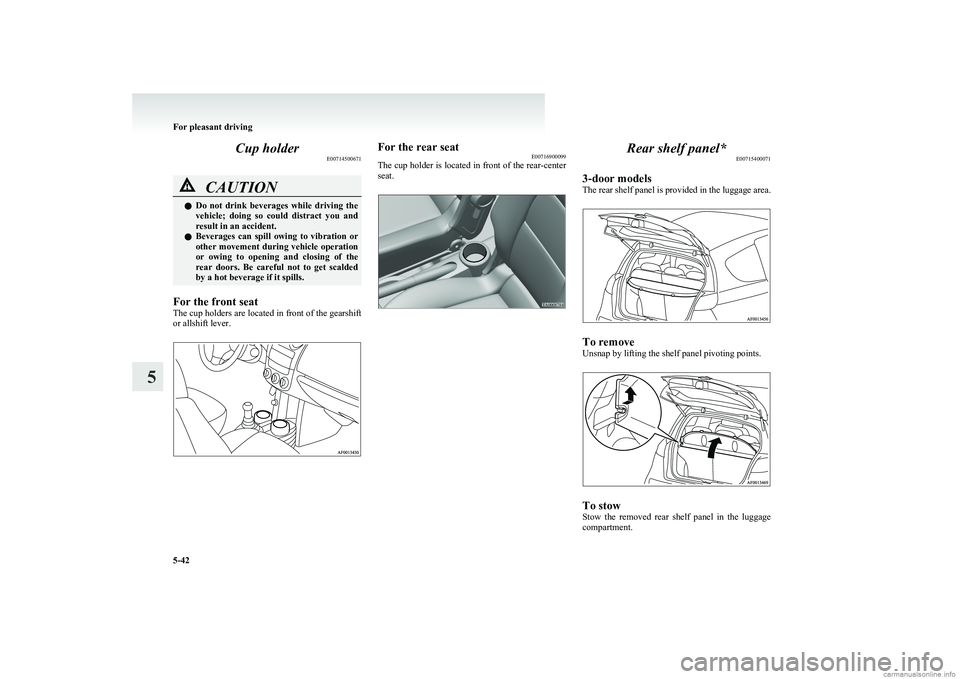
Cup holderE00714500671CAUTIONlDo not drink beverages while driving the
vehicle; doing so could distract you and
result in an accident.
l Beverages can spill owing to vibration or
other movement during vehicle operation
or owing to opening and closing of the
rear doors. Be careful not to get scalded
by a hot beverage if it spills.
For the front seat
The cup holders are located in front of the gearshift
or allshift lever.
For the rear seat E00716900099
The cup holder is located in front of the rear-center
seat.Rear shelf panel* E00715400071
3-door models
The rear shelf panel is provided in the luggage area.
To remove
Unsnap by lifting the shelf panel pivoting points.
To stow
Stow the removed rear shelf panel in the luggage
compartment.
For pleasant driving
5-42
5
Page 185 of 274
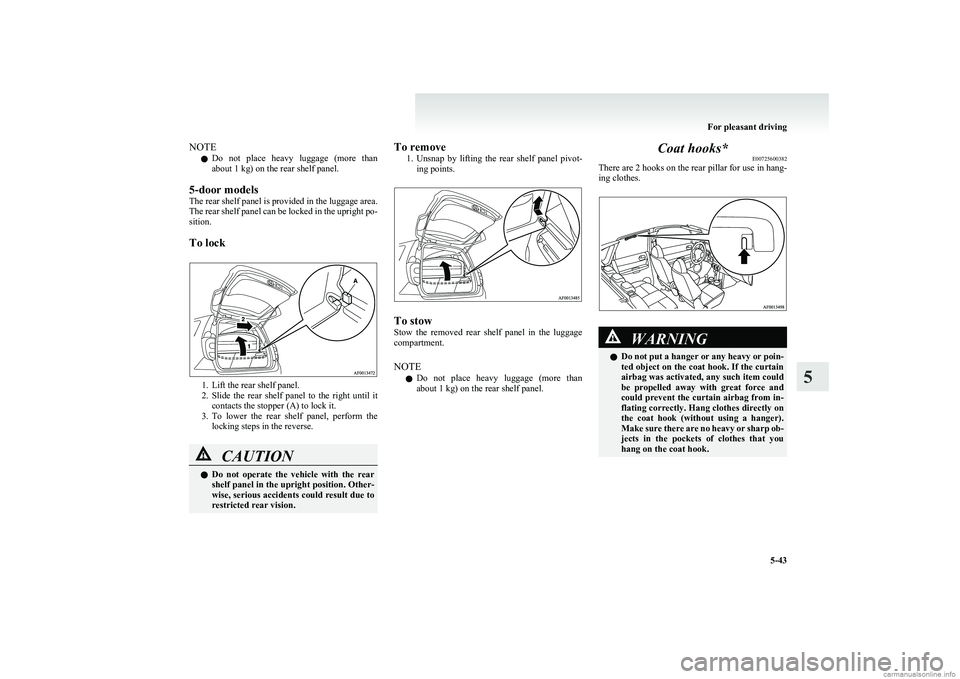
NOTEl Do not place heavy luggage (more than
about 1 kg) on the rear shelf panel.
5-door models
The rear shelf panel is provided in the luggage area.
The rear shelf panel can be locked in the upright po-
sition.
To lock
1. Lift the rear shelf panel.
2. Slide the rear shelf panel to the right until it
contacts the stopper (A) to lock it.
3. To lower the rear shelf panel, perform the
locking steps in the reverse.
CAUTIONl Do not operate the vehicle with the rear
shelf panel in the upright position. Other-
wise, serious accidents could result due to
restricted rear vision.To remove
1.Unsnap by lifting the rear shelf panel pivot-
ing points.
To stow
Stow the removed rear shelf panel in the luggage
compartment.
NOTE l Do not place heavy luggage (more than
about 1 kg) on the rear shelf panel.
Coat hooks* E00725600382
There are 2 hooks on the rear pillar for use in hang-
ing clothes.WARNINGl Do not put a hanger or any heavy or poin-
ted object on the coat hook. If the curtain
airbag was activated, any such item could
be propelled away with great force and
could prevent the curtain airbag from in-
flating correctly. Hang clothes directly on
the coat hook (without using a hanger).
Make sure there are no heavy or sharp ob-
jects in the pockets of clothes that you
hang on the coat hook.
For pleasant driving
5-43
5
Page 186 of 274

Page 187 of 274
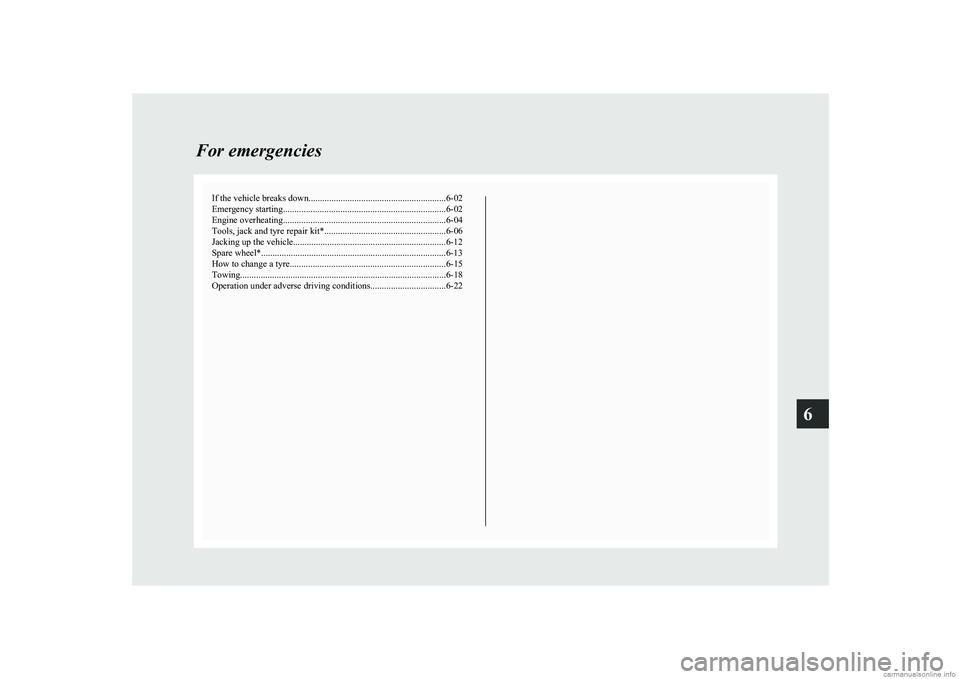
If the vehicle breaks down............................................................ 6-02
Emergency starting ....................................................................... 6-02
Engine overheating ....................................................................... 6-04
Tools, jack and tyre repair kit* ..................................................... 6-06
Jacking up the vehicle...................................................................6-12
Spare wheel*.................................................................................6-13
How to change a tyre .................................................................... 6-15
Towing .......................................................................................... 6-18
Operation under adverse driving conditions .................................6-22For emergencies6
Page 188 of 274
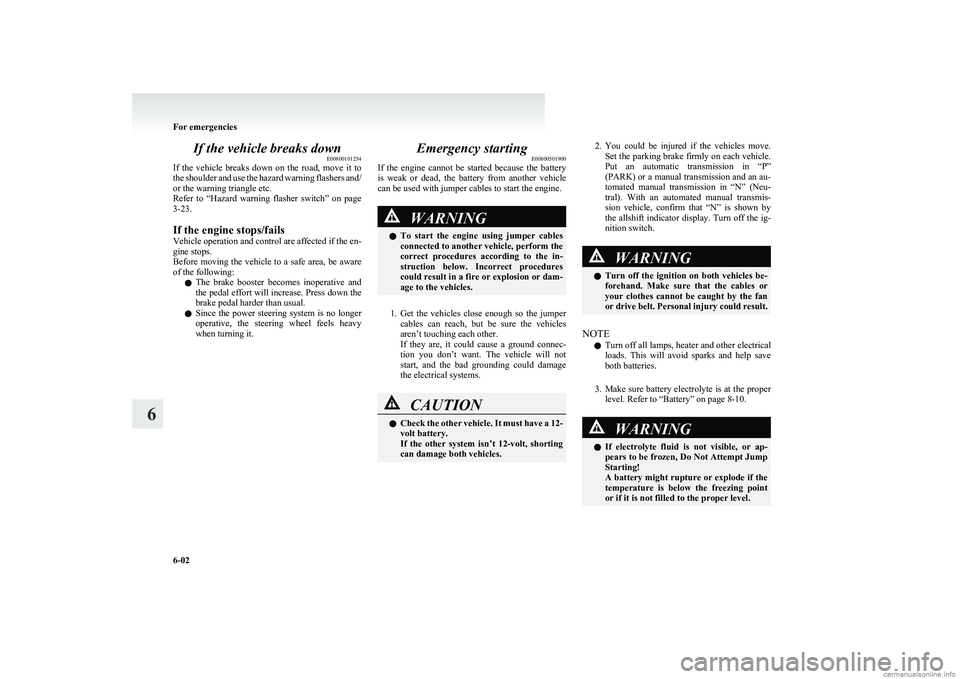
If the vehicle breaks downE00800101254
If the vehicle breaks down on the road, move it to
the shoulder and use the hazard warning flashers and/
or the warning triangle etc.
Refer to “Hazard warning flasher switch” on page
3-23.
If the engine stops/fails
Vehicle operation and control are affected if the en-
gine stops.
Before moving the vehicle to a safe area, be aware
of the following:
l The brake booster becomes inoperative and
the pedal effort will increase. Press down the
brake pedal harder than usual.
l Since the power steering system is no longer
operative, the steering wheel feels heavy
when turning it.Emergency starting E00800501900
If the engine cannot be started because the battery
is weak or dead, the battery from another vehicle
can be used with jumper cables to start the engine.WARNINGl To start the engine using jumper cables
connected to another vehicle, perform the
correct procedures according to the in-
struction below. Incorrect procedures
could result in a fire or explosion or dam-
age to the vehicles.
1. Get the vehicles close enough so the jumper
cables can reach, but be sure the vehicles
aren’t touching each other.
If they are, it could cause a ground connec-
tion you don’t want. The vehicle will not
start, and the bad grounding could damage
the electrical systems.
CAUTIONl Check the other vehicle. It must have a 12-
volt battery.
If the other system isn’t 12-volt, shorting
can damage both vehicles.2. You could be injured if the vehicles move.
Set the parking brake firmly on each vehicle.
Put an automatic transmission in “P”
(PARK) or a manual transmission and an au-
tomated manual transmission in “N” (Neu-
tral). With an automated manual transmis-
sion vehicle, confirm that “N” is shown by
the allshift indicator display. Turn off the ig-
nition switch.WARNINGl Turn off the ignition on both vehicles be-
forehand. Make sure that the cables or
your clothes cannot be caught by the fan
or drive belt. Personal injury could result.
NOTE
l Turn off all lamps, heater and other electrical
loads. This will avoid sparks and help save
both batteries.
3. Make sure battery electrolyte is at the proper
level. Refer to “Battery” on page 8-10.
WARNINGl If electrolyte fluid is not visible, or ap-
pears to be frozen, Do Not Attempt Jump
Starting!
A battery might rupture or explode if the
temperature is below the freezing point
or if it is not filled to the proper level.
For emergencies
6-02
6
Page 189 of 274
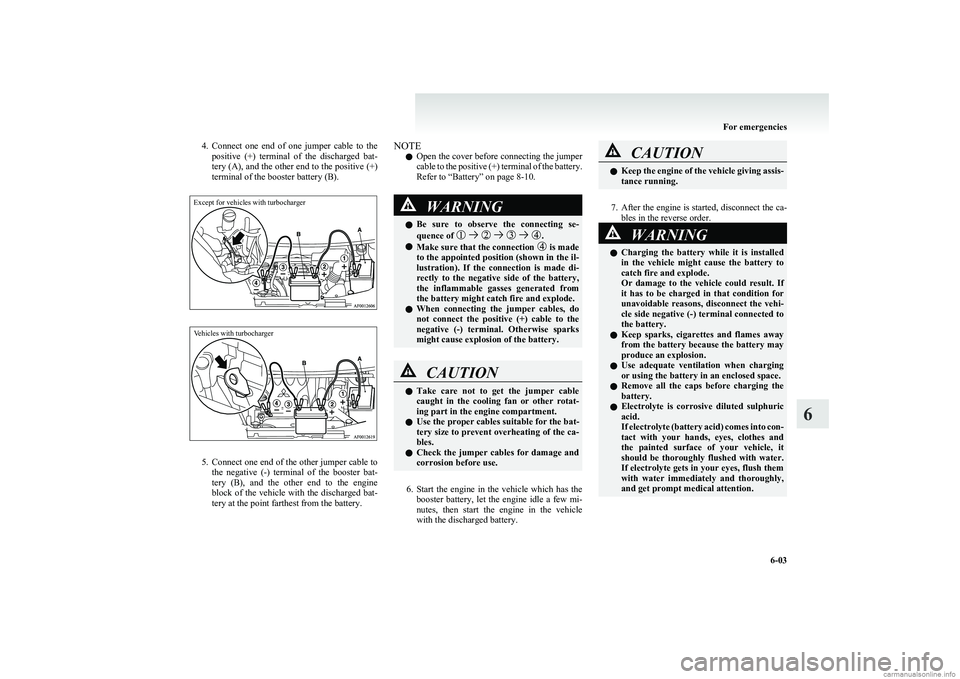
4.Connect one end of one jumper cable to the
positive (+) terminal of the discharged bat-
tery (A), and the other end to the positive (+)
terminal of the booster battery (B).Except for vehicles with turbochargerVehicles with turbocharger
5. Connect one end of the other jumper cable to
the negative (-) terminal of the booster bat-
tery (B), and the other end to the engine
block of the vehicle with the discharged bat-
tery at the point farthest from the battery.
NOTE
l Open the cover before connecting the jumper
cable to the positive (+) terminal of the battery.
Refer to “Battery” on page 8-10.WARNINGl Be sure to observe the connecting se-
quence of .
l Make sure that the connection is made
to the appointed position (shown in the il-
lustration). If the connection is made di-
rectly to the negative side of the battery,
the inflammable gasses generated from
the battery might catch fire and explode.
l When connecting the jumper cables, do
not connect the positive (+) cable to the
negative (-) terminal. Otherwise sparks
might cause explosion of the battery.
CAUTIONl Take care not to get the jumper cable
caught in the cooling fan or other rotat-
ing part in the engine compartment.
l Use the proper cables suitable for the bat-
tery size to prevent overheating of the ca-
bles.
l Check the jumper cables for damage and
corrosion before use.
6. Start the engine in the vehicle which has the
booster battery, let the engine idle a few mi-
nutes, then start the engine in the vehicle
with the discharged battery.
CAUTIONl Keep the engine of the vehicle giving assis-
tance running.
7. After the engine is started, disconnect the ca-
bles in the reverse order.
8.
WARNINGl Charging the battery while it is installed
in the vehicle might cause the battery to
catch fire and explode.
Or damage to the vehicle could result. If
it has to be charged in that condition for
unavoidable reasons, disconnect the vehi-
cle side negative (-) terminal connected to
the battery.
l Keep sparks, cigarettes and flames away
from the battery because the battery may
produce an explosion.
l Use adequate ventilation when charging
or using the battery in an enclosed space.
l Remove all the caps before charging the
battery.
l Electrolyte is corrosive diluted sulphuric
acid.
If electrolyte (battery acid) comes into con-
tact with your hands, eyes, clothes and
the painted surface of your vehicle, it
should be thoroughly flushed with water.
If electrolyte gets in your eyes, flush them
with water immediately and thoroughly,
and get prompt medical attention.
For emergencies
6-03
6
Page 190 of 274
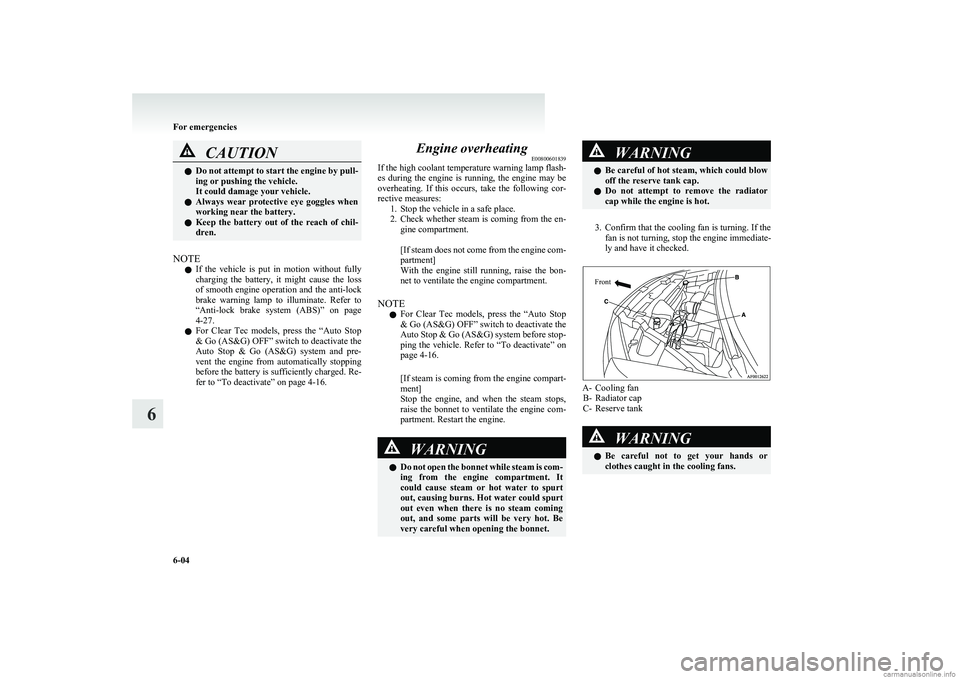
CAUTIONlDo not attempt to start the engine by pull-
ing or pushing the vehicle.
It could damage your vehicle.
l Always wear protective eye goggles when
working near the battery.
l Keep the battery out of the reach of chil-
dren.
NOTE
l If the vehicle is put in motion without fully
charging the battery, it might cause the loss
of smooth engine operation and the anti-lock
brake warning lamp to illuminate. Refer to
“ Anti-lock brake system (ABS)” on page
4-27.
l For Clear Tec models, press the “Auto Stop
& Go (AS&G) OFF” switch to deactivate the
Auto Stop & Go (AS&G) system and pre-
vent the engine from automatically stopping
before the battery is sufficiently charged. Re-
fer to “To deactivate” on page 4-16.
Engine overheating E00800601839
If the high coolant temperature warning lamp flash-
es during the engine is running, the engine may be
overheating. If this occurs, take the following cor-
rective measures: 1. Stop the vehicle in a safe place.
2. Check whether steam is coming from the en-
gine compartment.
[ If steam does not come from the engine com-
partment]
With the engine still running, raise the bon-
net to ventilate the engine compartment.
NOTE l For Clear Tec models, press the “Auto Stop
& Go (AS&G) OFF” switch to deactivate the
Auto Stop & Go (AS&G) system before stop-
ping the vehicle. Refer to “To deactivate” on
page 4-16.
[If steam is coming from the engine compart-
ment]
Stop the engine, and when the steam stops,
raise the bonnet to ventilate the engine com-
partment. Restart the engine.WARNINGl Do not open the bonnet while steam is com-
ing from the engine compartment. It
could cause steam or hot water to spurt
out, causing burns. Hot water could spurt
out even when there is no steam coming
out, and some parts will be very hot. Be
very careful when opening the bonnet.WARNINGl Be careful of hot steam, which could blow
off the reserve tank cap.
l Do not attempt to remove the radiator
cap while the engine is hot.
3. Confirm that the cooling fan is turning. If the
fan is not turning, stop the engine immediate-
ly and have it checked.
Front
A- Cooling fan B- Radiator cap
C- Reserve tank
WARNINGl Be careful not to get your hands or
clothes caught in the cooling fans.
For emergencies
6-04
6